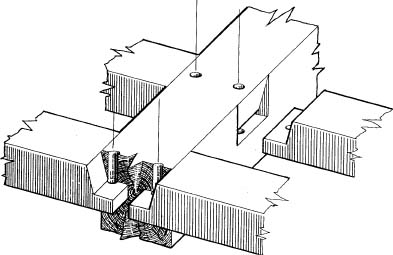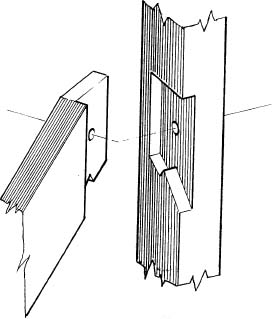Timber Framed Buildings and Roofs
Paul Russell
HISTORY
Before
the close of the 11th century, the rebuilding of the Saxon churches had
begun at Canterbury, Gloucester, St. Albans, Ely, Durham and Lindisfarne.
An additional 20 new sites running from Battle to Tynemouth had also been
colonised by monks. Throughout the 12th century this continued at an increasing
rate and by the mid 13th century another three hundred convents, financed
by land grants and endowments, were constructing abbeys or priories, and
other ancillary buildings.
Whilst these edifices were in their final form, invariably constructed of stone, they took years to complete. It was therefore the job of carpenters to construct temporary chapels, accommodation and storage facilities for the founding communities during interim periods. These highly skilled and important craftsmen also arranged the scaffold for the masons as work on the walls progressed and constructed the complex, load bearing formwork. Upon these, the arches and vaults could be assembled before finally raising the framework to support the building's protective covering. Durham Cathedral Priory Church is a good example of the length of construction for a project. It was completed in 1133 after 40 years' work. Its cloisters, chapter-house, dormitories, kitchen cellars and reception buildings were added later.
The growth of religious communities was mirrored in the development of new construction techniques. Master carpenters began to develop specialised jointing techniques and explore the mechanics of structures. By the mid 14th century, they were able to produce structures like the internal scaffold frame for Salisbury Cathedral spire and the octagon and lantern which float above the crossing of Ely Cathedral. The culmination of this craftsmanship occurred in 1400 with the completion of Master Hugh Harland's 'hammerbeam' roof to the Great Hall at Westminster. Here, he transcended the limitations of timber lengths to create the largest clear-span roof in the world and a work of outstanding beauty.
Vernacular building, which didn't have the backing of Church and State, was slow to absorb and react to these developments. Instead, it tended to be predominantly influenced by tradition and local custom. 'Cruck-framing', where the roof is carried by paired curved timbers from ground level to ridge, found predominantly in the Midlands, Mid Wales, the North and West of Britain, may represent the survival well into the 16th century of timber framing techniques from a pre-Norman, possibly Celtic, culture. Box framing, on the other hand, seems to have developed predominantly in the South and East of England. The introduction of the 'cill beam', a horizontal wooden base into which timber posts were tenoned to overcome problems associated with earth fast wall members, was attributable to the Saxons.
The 'sans-purlin' roof of the medieval hall was simple. Uniformly sized rafter couples, joined by a collar, were held vertical by steep hips at each end, with intervening rafter spaces maintained solely by the thatch or tile battens.
Larger roofs were given the additional support of 'scissor' or 'passing braces'. After 1350 use of a central purlin braced to crown posts mounted on the tie beams became widespread in the southeast and continued in use for the next 200 years.
Larger sectioned principal rafters, jointed into the tie beam to form a truss which could carry side purlins, came into general use towards the end of the 15th century. These took the form of butt purlins tenoned into the side of the principals or clasped purlins held between a deep collar and the principal's inner face. In areas with a cruck tradition, these principals tended to be heavy, carrying trenched purlins in notches on their outer faces and ridge beams at the truss apex.
The dissolution of the monasteries in the 16th century precipitated a change in building layout from the open hall to houses more suited to occupation by a priest or member of the emerging merchant class. These incorporated smoke bays or brick chimneys through framed floors at storey height, with glazed casements gradually replacing the open 'wind eye' or 'wind hole'. In line with this development, the open hearth was slowly eliminated from the halls by the introduction of the chimney allowing the hall to be modified by the insertion of a floor.
Release of the monastic woodlands also had its effects as the increase in available timber promoted a period of conspicuous consumption in such practices as close studding, ornamental panelling, heavy mouldings and decorative carving. As domestic oak stocks dwindled during the 17th century rising prices led to the importation of Baltic softwood as well as oak billets to supply the continuing demand for cleft oak panel interiors.
The Great Fire of London in 1666 gave added impetus to the fashion for brick construction favoured by the new architects for its greater design flexibility, and marked the beginning of a decline in the timber frame tradition.
 |
||
| Joist end tenon with diminished haunch. First use thought to be at King's College Chapel, Cambridge, 1510-1512, where it was found on side purlins (Hewett) |
Architects began to look to Europe for inspiration and introduced from Italy the 'stressed' truss in which a 'king-post' is suspended from the top of the principals, picking up the dead load weight of the tie beam at its base. This, in combination with the great lengths available in the imported softwoods, gave the ability to bridge wide spans with roofs of low pitch. The king-post and its variant, the 'queen-post' truss, was much used during the 18th century with the addition of iron straps and tension bolts. The circulation of manuals giving construction details, the mechanisation of timber conversion and the sourcing of new softwood supplies from North America brought about the 'laminated' truss. These foreshadowed the mechanical trusses of the 19th century as solutions were sought for the roofs of industrialised England.
Victorian Gothic had the tendency to be an applied visual effect; ornate hammerbeam forms being suspended from more conventional roof structures or held together by iron ties. Exteriors on the other hand, were decorated with elaborate fake half-timbering. Though carpenters remained responsible for the framing of floors and roofs, the traditional framing of timber buildings had been largely relegated to agricultural purposes.
The problems encountered in timber framed structures fall into three main categories: insect attack, fungal decay and mechanical damage.
MECHANICAL FAILURE
If
a building is able to rack or twist, placing individual members under
excessive loads, then mechanical failure is likely to occur. This can
happen if:
i) the frame is inadequately braced
ii) foundations have moved
iii) a cill beam has deteriorated bracing.
The resulting forces of compression, tension and torsion, will eventually lead to mechanical damage when the timbers can no longer absorb them through deflection or crush. Failure may occur in the form of shear, joint failure; plate or post fracture; rafter spread or ultimate collapse.
More often than not such events are initiated by alterations or 'improvements' which have involved severing structural members to accommodate inserted floors, communicating doors, additional windows or relocated stairways. Internally, the removal of partition walls or, the installation of services in trenches cut through floor joists, may have severely reduced the structural frame, while beam ends encased in masonry walls can decay, allowing the beam to descend along with the floor joists.
REPAIRS
Before
timber repairs are put in hand, a drawn and measured survey of the building
should be prepared, showing:
i) the timber type, condition and dimensions
ii) surface finish or treatment
iii) position, nature of construction and assembly marks
iv) details of mouldings or decorative features
v) the exact location of any damage or distortion.
Since timber frames and roofs are designed to stand alone as a unit, it is our opinion that the repair should be aimed at restoring that unity. Carpentry solutions may therefore be preferred to alternative approaches - although this will often entail a degree of replacement. Under these circumstances, 'green' or unseasoned timber may be used when the dimensions required exceed 4 - 5 inches. (Dry stock is difficult to obtain and prohibitively costly for most applications.)
 |
|
| Notched lap joint designed to resist withdrawal, Coggeshall Abbey Barn, 1120-1147 (Hewett) |
When considering the replacement of such elements as shaped door heads, deep mouldings, large boards and panels or wide braces, dry stable material is essential. This is because subsequent shrinkage will cause distortion and possible damage to adjacent fabric.
An indication of conversion methods used in producing original members may be obtained by examination of the cross-section. Heart/sapwood orientation is important when considering the weathering of exposed timbers, whilst conversion methods dictate to a large degree, the surface finish, and at times, the final form.
For the individual trying to minimise the visual impact of a repair, the material which is to be permanently bonded to the original must be closely matched in type, moisture content, surface, sectional grain pattern and colour. This can easily be sourced from reclaimed material.
The glues used in bonding should be boil and waterproof (commonly two-part epoxy resins). Whilst this may also serve as a grout for bedding or to fill fissures up to 10mm, suppliers should be consulted regarding suitability for filling larger voids.
Where metal work is to be embedded in timber, as in flitch-plate repairs to fracture, stainless steel should be used for both plate and fixing pins or bolts. They should be set in a grout of resin and the entry point masked by the insertion of a timber fillet. Surface applied plates, straps or bands, may be of mild steel but adequate protection must be provided by the application of rust inhibiting coatings or paint, particularly, on contact surfaces.
~~~
Recommended Reading
- JR Armstrong,
Traditional Buildings Accessible to the Public, EP Publishing
Ltd, Wakefield, Yorks, 1979
- John and Nicola Ashurst,
Practical Building Conservation Vol 5, Gower
Technical Press, Aldershot, Hants, 1979
- RW Brunskill, Timber Building in England, Gollancz, London, 1985
- R Harris,
Discovering Timber Framed Buildings, Shire Publications,
Aylesbury, 1979
- David and Barbara Martin,
Domestic Building in the Eastern High Weald
1300-1750, Hastings Area Archaeological Papers, Robertsbridge,
1989
- Cecil A Hewett,
English Historic Carpentry, Phillimore and Co, Chichester,
1980
- David Yeomans, The Architect and the Carpenter, RIBA Publications, Riba Heinz Gallery, London, 1992



